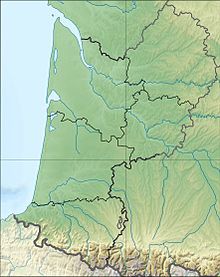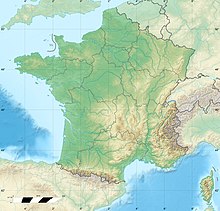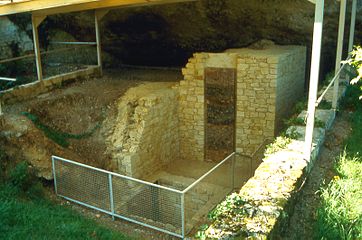Le Moustier
Le Moustier | |
 Le Moustier 1 in 1909 | |
| Location | Peyzac-le-Moustier |
|---|---|
| Region | Dordogne, France |
| Coordinates | 44°59′38″N 1°3′36″E / 44.99389°N 1.06000°E |
| Site notes | |
| Excavation dates | 1863 |
| Archaeologists | Henry Christy, Édouard Lartet. |
| Part of | Prehistoric Sites and Decorated Caves of the Vézère Valley |
| Criteria | Cultural: (i), (iii) |
| Reference | 85-014 |
| Inscription | 1979 (3rd Session) |
| Area | 0.227 ha (24,400 sq ft) |
Le Moustier is an archeological site consisting of two rock shelters in Peyzac-le-Moustier, a village in the Dordogne, France. It is known for a fossilized skull of the species Homo neanderthalensis that was discovered in 1908. The Mousterian tool culture is named after Le Moustier, which was first excavated from 1863 by the Englishman Henry Christy and the Frenchman Édouard Lartet.
The Le Moustier skull is estimated to be approximately 45,000 years old.[1] Its characteristics include a large nasal cavity and a somewhat less developed brow ridge and occipital bun, as might be expected in a juvenile.
After discovery, the skull was dismantled, cast and reconstructed at least four times. During this process, the skull received considerable amounts of damage; for example, when it was sold to the Museum für Völkerkunde in Berlin, a dentist broke the alveolar bone to access the teeth. The skull is now missing many parts, the teeth glued into the wrong position, and it has been dipped into glue, covered with varnish, and painted with plaster. Consequently its scientific value is much reduced. [2]
-
Upper shelter
-
Lower shelter
-
Flint handaxe, excavated 1863, British Museum
-
A box of side scrapers excavated by Lartet and Christy
References
- ^ Australian Museum [Retrieved 2012-01-06]
- ^ Weber, Gerhard (2011). Virtual anthropology : a guide to a new interdisciplinary field. Wien London: Springer. ISBN 978-3-211-48647-4.
See also
- List of fossil sites (with link directory)
- List of hominina (hominid) fossils (with images)
External links
 Media related to Le Moustier at Wikimedia Commons
Media related to Le Moustier at Wikimedia Commons






